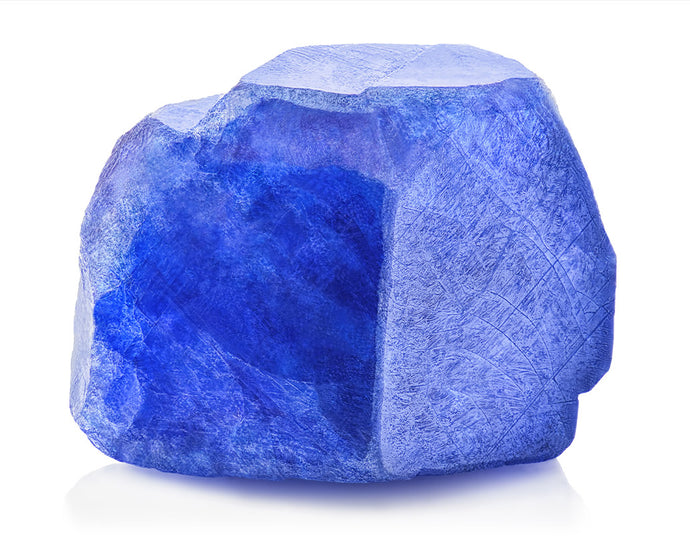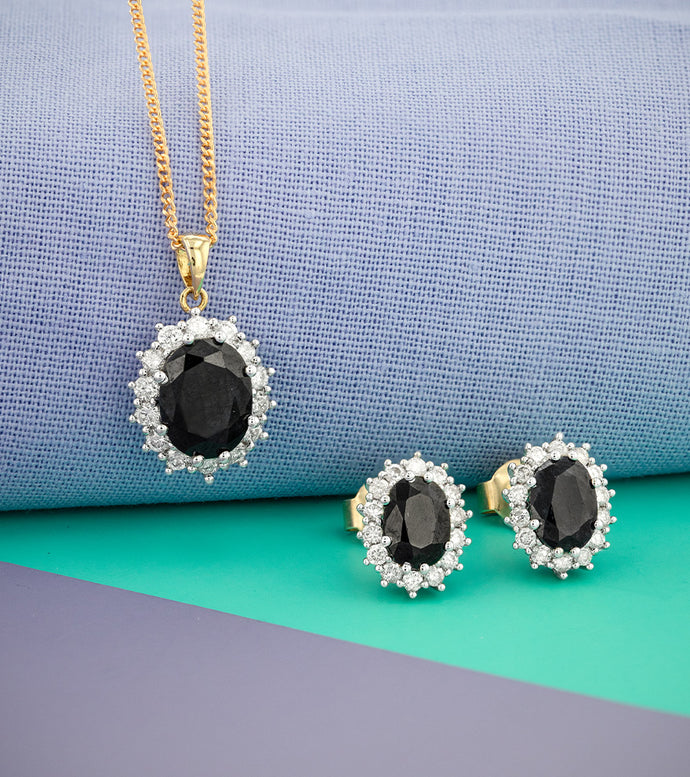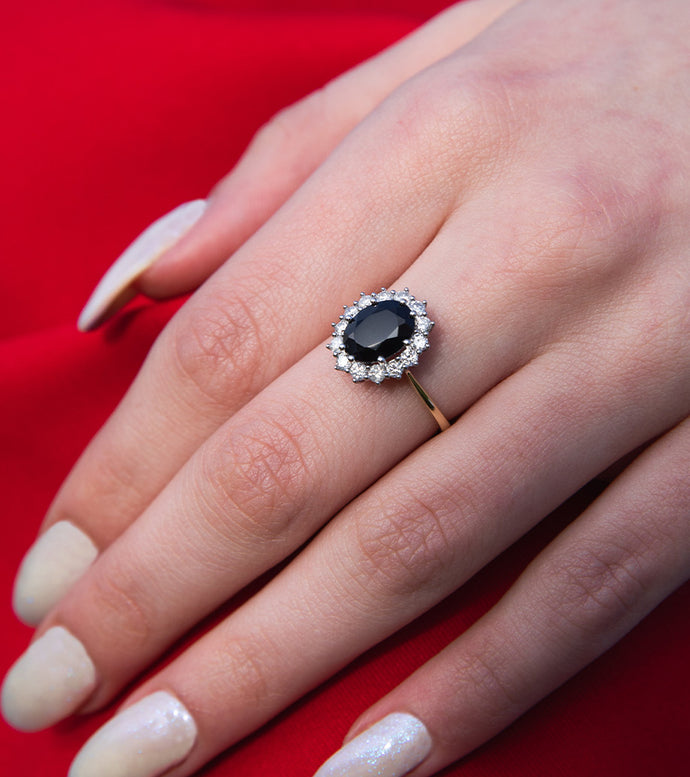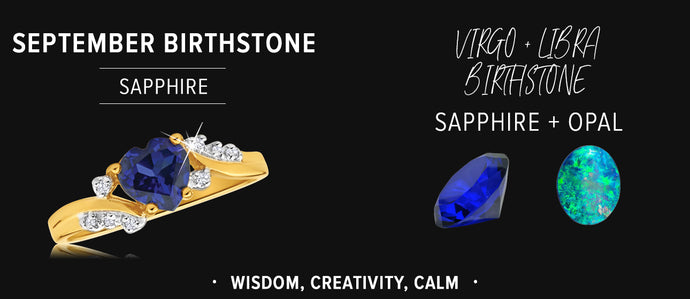September Birthstone
The September birthstone is a sapphire. A stone commonly associated with royalty and opulence, sapphires have been a highly sought after gemstone for centuries. Ancient Persians even believed that the sky was painted blue to represent the stone. Derived from sapphirus, a Latin word meaning blue', they are a popular alternative to diamond engagement rings. You will also find these mystical gemstones in everything from fancy drop earrings and dress rings to elegant pendants and more.
Ranking at 9 on the Mohs scale of hardness, Sapphires are a stone that is synonymous with their tough and scratch-resistant exterior. So, it's no wonder why sapphire jewellery has been adored by everyone from Hollywood icons to members of the royal family. This birthstone is one of a kind.
From its unmistakable blue hue to its interesting origins, read on as we unpack all there is to know about the fascinating September birthstone.
OVERVIEW OF THE SEPTEMBER BIRTHSTONE:

MEANINGS AND PHYSICAL PROPERTIES OF SAPPHIRE
Like rubies, a sapphire's physical properties are iron, titanium and nickel. These minerals are what gives the stone its vibrant colour. Although, it's important to note that a large portion of sapphires are treated to help enhance their colour to make them appear brighter. This is why the stones that are naturally very vibrant in colour are not only the most desirable but also the most valuable.
Despite being largely associated with a deep blue, almost navy shade, many will be surprised to know that sapphires come in all different colours of the rainbow including red, green, purple, yellow, orange and pink. There are even colourless sapphires that resemble diamonds and black stones which are highly sought after in jewellery, particularly for engagement rings. Because of this colour variation, sapphires have taken on many different meanings in their lifetime. Some of the concepts that sapphires are believed to represent include wisdom, virtue, good fortune and holiness. When it comes to sapphire engagement rings, they are thought to symbolise eternal love, faithfulness and sincerity.
In the olden days, many people wore sapphires around their neck as they believed the stone would protect them from harm by banishing evil spirits and sending negative spells back to their sender. They were even used to help ward off poisonous snakes. Sapphires are also thought to increase communication, awareness and a connection between a person and their spiritual guides, while also bringing good karma, purpose and focus. The stones are also seen to be great for calming the nerves, promoting mental clarity as well as helping with focus concentration. Perhaps you could consider investing in some sapphire jewellery to help you become more productive in the workplace?

HISTORY OF SAPPHIRE
Adored by civilisations for thousands of years, sapphires have garnered a myriad of uses in their lifetime. In Ancient Egypt, the Egyptians believed that the stones represented the wisdom of the all-seeing Eye of Horus. They used the stone to help cure particular medical ailments such as rheumatoid arthritis, mental illness, colic and even to help strengthen one's eyesight. During this time, the Egyptians used sapphires in art and to help decorate monuments. In Ancient Greek and Roman societies, royal families and other dignitaries adorned sapphires to protect them from envy and harm from their enemies.
During the Middle Ages, clergymen sported sapphires to symbolise the promise of heaven and other divine blessings. The precious stone was also a popular item on the trade route which connects India to Europe during this time. Towards the end of the Middle Ages and the birth of the Renaissance, Italian goldsmiths and stone carvers would also repurpose sapphires into art. It was also during this period that women would adorn sapphire earrings, sapphire necklaces, sapphire rings and brooches which featured the stone.
In more modern times, it's hard not to associate these regal stones with royalty. In 1796, the French Emperor, Napoleon Bonaparte gave his beloved wife Josephine an engagement ring featuring a large diamond and sapphire stone. While arguably, the most infamous sapphire stone is the engagement ring given to Diana, the Princess of Wales by Prince Charles. While that marriage may have not lasted very long, the stone now lives on with Princess Diana's daughter-in-law Kate Middleton, the Duchess of Cambridge who was proposed to with the engagement ring by Prince William. And of course, the world's longest-reigning monarch, Queen Elizabeth II also has her fair share of sapphire jewels. Including the iconic George VI Victorian suite sapphire jewellery which consists of a sapphire tiara, diamond and sapphire drop earrings as well as a large sapphire pendants.

WHERE ARE SAPPHIRES FOUND?
Sapphire deposits were discovered in modern civilisation well over 300 years ago by a group of gold prospectors mining near the Missouri River in Helena, a city in Montana within the United States. Since then, Sapphires have been found all over the globe and are predominantly mined in Australia, Afghanistan, China, Colombia, Madagascar, Kenya, Laos, Sri Lanka, Myanmar, Nigeria, Thailand, Malawi, Mozambique, the United States, Vietnam, Ethiopia and several other countries. The world's largest exporter of the stone is Sri Lanka where their gem trade is said to generate over $130 million for the country annually.
The largest sapphire stone ever found in the Star of Adam. Only discovered in 2016 within the Ratnapura region of Sri Lanka, this light blue weighs a staggering 1,404 carats and is worth an eye-watering $300 million. The world's second-largest sapphire is the 733 carat Black Star of Queensland which was discovered in the early 1930s.

OUR FAVOURITE SEPTEMBER BIRTHSTONE JEWELLERY
Channel opulence and royalty with sapphire jewellery from Shiels. The vibrancy of royal blue sapphires will add a pop of colour to your look while inspiring an affluent sense of style.










































